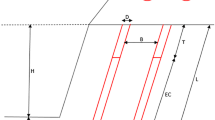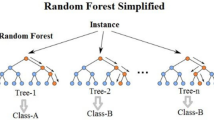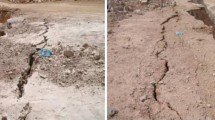Abstract
One of the major problems related to blasting operations in open pit mines is the formation of cracks on the benches behind the last row of blast holes (backbreak). Prediction of backbreak plays an important role in the safety of open pit mining and the reduction of the detrimental effects resulting from blasting operations. In this study, we have tried to develop predictive models for anticipating backbreak. For this purpose, two of the most popular techniques, regression tree (RT) analysis and adaptive neuro-fuzzy inference system (ANFIS), were taken into account and a predictive model was constructed based on each. For training and testing of these models, a database including 175 blasting events in the Sungun Copper Mine (SCM), Iran, was used. These models predict backbreak based on the major blast design parameters (i.e., burden, spacing, stemming length, powder factor, and geometric stiffness ratio). It was found that both models can be used to predict the backbreak, but the comparison of two models, in terms of statistical performance indices, shows that the ANFIS model provides better results than the RT.





Similar content being viewed by others
References
Akbulut S, Hasiloglu AS, Pamukcu S (2004) Data generation for shear modulus and damping ratio in reinforced sands using adaptive neuro-fuzzy inference system. Soil Dyn Earthq Eng 24:805–814
Alejano LR, Pons B, Bastante FG, Alonso E, Stockhausen HW (2007) Slope geometry design as a means for controlling rockfalls in quarries. Int J Rock Mech Min Sci 44:903–921
Barlin JN, Zhou Q, St Clair CM, Iasonos A, Soslow RA, Alektiar KM, Hensley ML, Leitao MM Jr, Barakat RR, Abu-Rustum NR (2013) Classification and regression tree (CART) analysis of endometrial carcinoma: seeing the forest for the trees. Gynecol Oncol 130:452–456
Bauer A (1982) Wall control blasting in open pits. In: Proceedings of the 14th Canadian Rock Mechanics Symposium, Vancouver, British Columbia, Canada, May 1982. Canadian Institute of Mining and Metallurgy, CIM Special, vol 30, pp 3–10
Bhandari S (1997) Engineering rock blasting operations. Balkema, Rotterdam
Breiman L, Freidman J, Olshen R, Stone C (1984) Classification and regression trees. Wadsworth, Belmont
Ebrahimi E, Monjezi M, Khalesi MR, Armaghani Jahed (2015) Prediction and optimization of back-break and rock fragmentation using an artificial neural network and a bee colony algorithm. Bull Eng Geol Environ. doi:10.1007/s10064-015-0720-2
Esmaeili M, Osanloo M, Rashidinejad F, Aghajani Bazzazi A, Taji M (2014) Multiple regression, ANN and ANFIS models for prediction of backbreak in the open pit blasting. Eng Comput 30:549–558
Faradonbeh RS, Monjezi M, Jahed Armaghani D (2015) Genetic programing and non-linear multiple regression techniques to predict backbreak in blasting operation. Eng Comput. doi:10.1007/s00366-015-0404-3
Faramarzi F, Ebrahimi Farsangi MA, Mansouri H (2013) An RES-based model for risk assessment and prediction of backbreak in bench blasting. Rock Mech Rock Eng 46:877–887
Gate WC, Ortiz BLT, Florez RM (2005) Analysis of rockfall and blasting backbreak problems. In: Proceedings of the 40th US Symposium on Rock Mechanics (USRMS), Anchorage, Alaska, June 2005, vol 5, pp 671–680
Ghasemi E, Sari M, Ataei M (2012) Development of an empirical model for predicting the effects of controllable blasting parameters on flyrock distance in surface mines. Int J Rock Mech Min Sci 52:163–170
Gokceoglu C (2002) A fuzzy triangular chart to predict the uniaxial compressive strength of the Ankara agglomerates from their petrographic composition. Eng Geol 66:39–51
Gokceoglu C, Yesilnacar E, Sonmez H, Kayabasi A (2004) A neuro-fuzzy model for modulus of deformation of jointed rock masses. Comput Geotech 31:375–383
Gokhale BV (2011) Rotary drilling and blasting in large surface mines. CRC Press/Balkema, Netherlands
Grima MA (2000) Neuro-fuzzy modelling in engineering geology. Balkema, Rotterdam
Grima MA, Babuska R (1999) Fuzzy model for the prediction of unconfined compressive strength of rock samples. Int J Rock Mech Min Sci 36:339–349
Grima MA, Bruines PA, Verhoef PNW (2000) Modeling tunnel boring machine performance by neuro-fuzzy methods. Tunn Undergr Space Technol 15:260–269
Hajihassani M, Jahed Armaghani D, Monjezi M, Mohamad ET, Marto A (2015) Blast-induced air and ground vibration prediction: a particle swarm optimization-based artificial neural network approach. Environ Earth Sci 74:2799–2817
Iphar M, Yavuz M, Ak H (2008) Prediction of ground vibrations resulting from the blasting operations in an open-pit mine by adaptive neuro-fuzzy inference system. Environ Geol 56:97–107
Jahed Armaghani D, Hajihassani M, Marto A, Faradonbeh RS, Mohamad ET (2015a) Prediction of blast-induced air overpressure: a hybrid AI-based predictive model. Environ Monit Assess 187:1–13
Jahed Armaghani D, Hajihassani M, Sohaei H, Mohamad ET, Marto A, Motaghedi H, Moghaddam MR (2015b) Neuro-fuzzy technique to predict air-overpressure induced by blasting. Arab J Geosci. doi:10.1007/s12517-015-1984-3
Jahed Armaghani D, Momeni E, Abad SVANK, Khandelwal M (2015c) Feasibility of ANFIS model for prediction of ground vibrations resulting from quarry blasting. Environ Earth Sci 74:2845–2860
Jang JSR (1993) ANFIS: adaptive-network-based fuzzy inference system. IEEE Trans Syst Man Cybern 23:665–685
Jang JSR, Sun CT, Mizutani E (1997) Neuro-fuzzy and soft computing: a computational approach to learning and machine intelligence. Prentice Hall, Upper Saddle River, NJ
Jimeno CL, Jimeno EL, Carcedo FJA (1995) Drilling and blasting of rocks. Balkema, Rotterdam
Karami AR, Mansouri H, Ebrahimi Farsangi MA, Nezamabadi H (2006) Backbreak prediction due to bench blasting: an artificial neural network approach. J Mine Met Fuel 54:418–420
Kass GV (1980) An exploratory technique for investigating large quantities of categorical data. Appl Stat 20:119–127
Keshavarzi A, Gazni R, Homayoon SR (2012) Prediction of scouring and arch-shaped bed sill using Neuro-Fuzzy model. Appl Soft Comput 12:486–493
Khandelwal M, Monjezi M (2013) Prediction of backbreak in open pit blasting operations using the machine learning method. Rock Mech Rock Eng 46:389–396
Konya CJ, Walter EJ (1991) Rock blasting and overbreak control. United States Department of Transportation, McLean
Konya CJ, Walter EJ (2003) Rock blasting and overbreak control. National Highway Institute, Arlington
Kucuk K, Aksoy CO, Basarir H, Onargan T, Genis M, Ozacar V (2011) Prediction of the performance of impact hammer by adaptive neuro-fuzzy inference system modeling. Tunn Undergr Space Technol 26:38–45
Mohammadnejad M, Gholami R, Sereshki F, Jamshidi A (2013) A new methodology to predict backbreak in blasting operation. Int J Rock Mech Min Sci 60:75–81
Mohanty BB, Chung SH (1986) Production blasts in open pit mines and their effect on slope stability. In: Proceedings of the International Symposium on Geotechnical Stability in Surface Mining, Calgary, Alberta, Canada, November 1986. CANMET, pp 133–140
Monjezi M, Dehghani H (2008) Evaluation of effect of blasting pattern parameters on back break using neural networks. Int J Rock Mech Min Sci 45:1446–1453
Monjezi M, Rezaei M, Yazdian A (2010a) Prediction of backbreak in open-pit blasting using fuzzy set theory. Expert Syst Appl 37:2637–2643
Monjezi M, Sayadi A, Talebi N (2010b) Prediction of backbreak using blasting parameters. J Mine Met Fuel 58:223–226
Monjezi M, Amini Khoshalan H, Yazdian Varjani A (2011) Optimization of open pit blast parameters using genetic algorithm. Int J Rock Mech Min Sci 48:864–869
Monjezi M, Amini Khoshalan H, Yazdian Varjani A (2012) Prediction of flyrock and backbreak in open pit blasting operation: a neuro-genetic approach. Arab J Geosci 5:441–448
Monjezi M, Ahmadi Z, Yazdian Varjani A, Khandelwal M (2013) Backbreak prediction in the Chadormalu iron mine using artificial neural network. Neural Comput Appl 23:1101–1107
Nelson M, Illingworth WT (1990) A practical guide to neural nets. Addison-Wesley, Reading
Osei-Bryson KM (2008) Post-pruning in regression tree induction: an integrated approach. Expert Syst Appl 34:1481–1490
Saghatforoush A, Monjezi M, Faradonbeh RS, Jahed Armaghani D (2015) Combination of neural network and ant colony optimization algorithms for prediction and optimization of flyrock and back-break induced by blasting. Eng Comput. doi:10.1007/s00366-015-0415-0
Sari M, Ghasemi E, Ataei M (2014) Stochastic modeling approach for the evaluation of backbreak due to blasting operations in open pit mines. Rock Mech Rock Eng 47:771–783
Sayadi A, Monjezi M, Talebi N, Khandelwal M (2013) A comparative study on the application of various artificial neural networks to simultaneous prediction of rock fragmentation and backbreak. J Rock Mech Geotech Eng 5:318–324
Scoble MJ, Lizotte YC, Paventi M, Mohanty BB (1997) Measurement of blast damage. Min Eng 49:103–108
Sengur A (2008) Wavelet transform and adaptive neuro-fuzzy inference system for color texture classification. Expert Syst Appl 34:2120–2128
Singh TN, Singh V (2005) An intelligent approach to predict and control ground vibration in mines. Geotech Geol Eng 23:249–262
Singh TN, Kanchan R, Verma AK, Saigal K (2005) A comparative study of ANN and Neuro-fuzzy for the prediction of dynamic constant of rockmass. J Earth Syst Sci 114:75–86
Singh R, Kainthola A, Singh TN (2012) Estimation of elastic constant of rocks using an ANFIS approach. Appl Soft Comput 12:40–45
Swingler K (1996) Applying neural networks: a practical guide. Academic Press, New York
Tayebi Khorami M, Chehreh Chelgani S, Hower JC, Jorjani E (2011) Studies of relationships between Free Swelling Index (FSI) and coal quality by regression and Adaptive Neuro Fuzzy Inference System. Int J Coal Geol 85:65–71
Tiryaki B (2008) Predicting intact rock strength for mechanical excavation using multivariate statistics, artificial neural networks, and regression trees. Eng Geol 99:51–60
Tiryaki B (2009) Estimating rock cuttability using regression trees and artificial neural networks. Rock Mech Rock Eng 42:939–946
Tutmez B, Hatipoglu Z, Kaymak U (2006) Modelling electrical conductivity of groundwater using an adaptive neuro-fuzzy inference system. Comput Geosci 32:421–433
Varol Y, Koca A, Oztop HF, Avci E (2007) Analysis of adaptive-network-based fuzzy inference system (ANFIS) to estimate buoyancy-induced flow field in partially heated triangular enclosures. Expert Syst Appl 35:1989–1997
Verbyla DL (1987) Classification trees: a new discrimination tool. Can J For Res 17:1150–1152
Wyllie DC, Mah CW (2004) Rock slope engineering: civil and mining, 4th edn. Spoon Press, New York
Yilmaz I, Kaynar O (2011) Multiple regression, ANN (RBF, MLP) and ANFIS models for prediction of swell potential of clayey soils. Expert Syst Appl 38:5958–5966
Yilmaz I, Yuksek G (2009) Prediction of the strength and elasticity modulus of gypsum using multiple regression, ANN, and ANFIS models. Int J Rock Mech Min Sci 46:803–810
Author information
Authors and Affiliations
Corresponding author
Rights and permissions
About this article
Cite this article
Ghasemi, E., Amnieh, H.B. & Bagherpour, R. Assessment of backbreak due to blasting operation in open pit mines: a case study. Environ Earth Sci 75, 552 (2016). https://doi.org/10.1007/s12665-016-5354-6
Received:
Accepted:
Published:
DOI: https://doi.org/10.1007/s12665-016-5354-6




